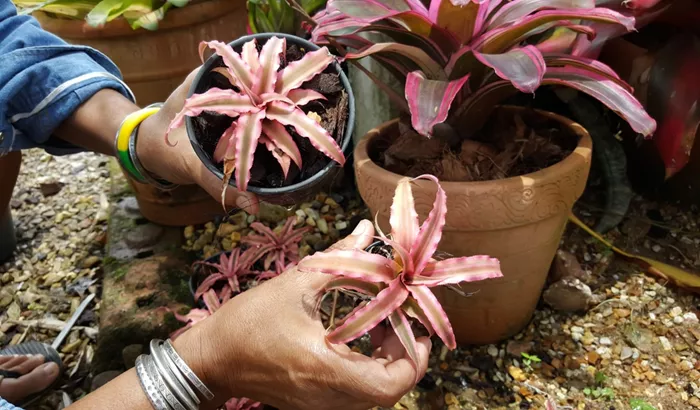Bromeliads are a captivating family of plants that have gained popularity among gardening enthusiasts for their unique shapes, vibrant colors, and fascinating growth habits. One of the most intriguing aspects of bromeliads is their ability to produce offsets, commonly known as “pups.” These pups can be a source of great excitement for gardeners, as they represent the potential for new life and blooms. In this blog post, we will explore the journey of bromeliad pups, including how long they take to flower, care tips, and the enchanting world of bromeliad varieties.
Understanding Bromeliads
Before delving into the specifics of bromeliad pups and their flowering timeline, it’s essential to understand what bromeliads are. Native primarily to tropical regions of the Americas, bromeliads belong to the family Bromeliaceae and are characterized by their rosette-shaped leaves and striking inflorescences. They thrive in diverse environments, from rainforests to arid deserts, making them adaptable houseplants.
The Lifecycle of Bromeliads
Bromeliads have a unique lifecycle that includes both vegetative growth and flowering. Typically, a mature bromeliad will produce a flower spike that can last for several months. After flowering, the plant will begin to produce pups at its base. These pups are clones of the parent plant and can be separated once they reach a suitable size.
The Journey of Bromeliad Pups
What Are Bromeliad Pups?
Bromeliad pups are small offshoots that emerge from the base of a mature bromeliad. They are essentially miniatures of the parent plant and can be propagated to create new plants. The process of pup formation is a natural part of the bromeliad’s lifecycle and occurs after the parent plant has flowered.
How Long Do Bromeliad Pups Take To Flower?
The time it takes for bromeliad pups to flower can vary significantly based on several factors:
Species Variation: Different species of bromeliads have varying growth rates and flowering timelines. For instance, some species may take as little as 6 months to flower after being separated from the parent plant, while others may take up to 3 years.
Growing Conditions: The environment in which the pups are grown plays a crucial role in their development. Factors such as light, temperature, humidity, and water availability can influence how quickly a pup matures and flowers.
Care Practices: Proper care is vital for encouraging healthy growth in bromeliad pups. Providing adequate light (bright indirect light), maintaining consistent moisture levels (without overwatering), and ensuring proper fertilization can significantly affect flowering time.
General Timeline for Flowering
On average, here’s a general timeline for when you can expect bromeliad pups to flower:
0-6 Months: Pups begin to establish roots and grow leaves.
6-12 Months: Pups may reach maturity; some species may start developing flower spikes.
1-2 Years: Most pups will flower within this timeframe if provided with optimal conditions.
2-3 Years: For slower-growing species or those in less-than-ideal conditions, flowering may take longer.
Caring for Bromeliad Pups
To ensure your bromeliad pups reach their full potential and bloom beautifully, follow these care guidelines:
1. Light Requirements
Bromeliads thrive in bright indirect light. Direct sunlight can scorch their leaves, while too little light can hinder growth. A north or east-facing window is often ideal for indoor cultivation.
2. Watering Practices
Bromeliads prefer well-draining soil and should not sit in waterlogged conditions. Watering should be done when the top inch of soil feels dry. Additionally, filling the central rosette with water can help maintain humidity levels.
3. Humidity Levels
As tropical plants, bromeliads enjoy higher humidity levels (around 50% or more). If your home is dry, consider using a humidity tray or misting your plants occasionally.
4. Fertilization
During the growing season (spring and summer), use a diluted liquid fertilizer formulated for bromeliads or orchids every 4-6 weeks to encourage healthy growth.
5. Repotting
Once your pup has established roots (usually after about 6 months), you can repot it into its own container with fresh potting mix designed for epiphytic plants.
Popular Bromeliad Varieties
Exploring different varieties of bromeliads can enhance your gardening experience. Here are some popular types known for their stunning blooms:
1. Guzmania
Guzmania is famous for its tubular flowers that bloom in vibrant colors like red, orange, and yellow. They typically flower within 1-2 years after being propagated from pups.
2. Aechmea
Aechmea is recognized for its unique inflorescence resembling a pineapple. It usually takes about 1-2 years for pups to flower.
3. Neoregalia
Neoregalia features stunning foliage with vibrant colors and patterns that change with light exposure. These pups generally take around 1-3 years to bloom.
4. Tillandsia
Tillandsia, also known as air plants, do not require soil and can thrive in various environments. Their flowering time varies widely but often occurs within 1-2 years after propagation.
Conclusion
In conclusion, understanding how long bromeliad pups take to flower involves considering various factors such as species type, growing conditions, and care practices. With proper attention and nurturing, these delightful plants can reward you with breathtaking blooms that add vibrancy to any space.
As you embark on your journey with bromeliads—whether you’re cultivating pups or admiring mature specimens—remember that patience is key. Each pup has its own timeline for blossoming into beauty; enjoy every step along the way! Happy gardening!


